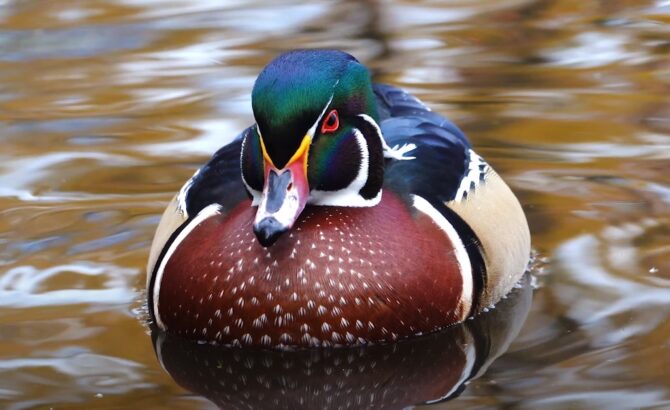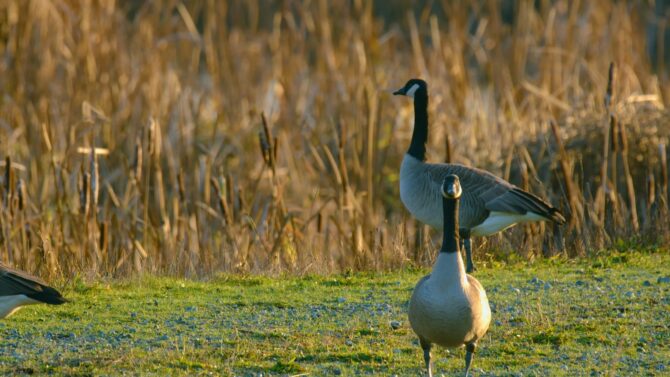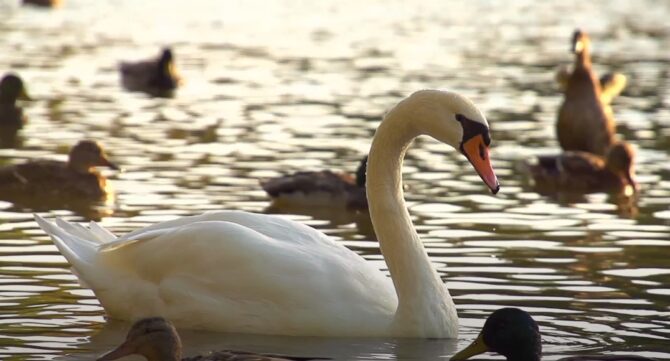Many people confuse ducks, geese, and swans, thinking they are similar. However, they are quite different in many ways. This article aims to clear up these confusions by explaining the unique features of each bird.
We will look at their size, behavior, and living habits to show how they differ from one another.
Key Takeaways
- Ducks are divided into dabblers and divers, with dabblers having brighter plumage and shorter necks, and divers being larger with more muted colors.
- Geese are larger than ducks, with long necks and less colorful plumage.
- Swans are the largest of the three, with elongated necks and usually white or black plumage.
- Ducks, geese, and swans have different lifespans. Ducks live up to 10 years, geese up to 24 years, and swans 20-30 years.
Ducks: Dabblers and Divers

Ducks are perhaps the most familiar and diverse of the three. They are generally smaller than geese and swans, with a wide range of colors and patterns. These birds are divided into two main categories: dabblers and divers.
Dabblers
- Physical Traits: Dabblers usually have brighter plumage and shorter necks. They have broad, flat bills for filtering food from the water. Their plumage often features intricate patterns and vibrant colors, serving as camouflage among aquatic plants. The unique structure of their bills allows them to sift and strain food from the water efficiently.
- Behavior: These ducks feed on the water’s surface, often tipping forward to graze on underwater plants. They are agile fliers, taking off directly from the water. Dabbling ducks are also known for their social behavior, frequently forming large groups during migration. Their feeding technique, known as “dabbling,” is a signature behavior where their tails point upwards while their heads submerge to reach aquatic vegetation. Interestingly, their diet varies significantly depending on whether they are in the wild or living as pets, with a diverse range of foods sustaining them in different environments.
Divers

- Physical Traits: Divers are typically larger with more muted colors. They have pointed bills and large feet positioned towards the rear. This body structure aids in diving and swimming underwater, providing powerful propulsion. Their plumage, while less colorful, is adapted for better underwater camouflage against predators.
- Behavior: As the name suggests, these ducks dive underwater to find food. They are powerful swimmers but take off from the water with more effort, needing a running start. Diving ducks are adept at staying submerged for extended periods, allowing them to reach deeper food sources. Unlike dabblers, they often feed in deeper waters where they can find fish and aquatic invertebrates.
Geese: Grazers of the Ground

Geese, larger than ducks and distinct in their migratory habits, stand out with their long necks, large bodies, and typically less colorful plumage. These characteristics make them easily distinguishable in the avian world.
Social Structure
Geese are highly social birds, often seen in large flocks. They form tight-knit communities, where members look out for each other, especially during nesting and migration.
These strong family bonds are a cornerstone of their survival, providing safety in numbers and increased efficiency in finding food.
Interestingly, geese communicate with a range of vocalizations, maintaining the cohesion of the flock and expressing emotions.
Feeding Habits
Unlike ducks, geese primarily graze on grasses and grains on land. Their diet includes a variety of grasses, seeds, and agricultural crops, making them versatile in different environments.
Geese have adapted their foraging behavior to efficiently graze, often rotating feeding grounds to allow vegetation to regrow.
This adaptability to various habitats, especially those near water, ensures their access to both food and safety.
Migration

Many goose species are renowned for their long migratory journeys, flying in a distinctive V-formation. This aerodynamic formation reduces wind resistance, enabling geese to fly long distances with less fatigue.
During these migrations, geese can cover thousands of miles, showcasing remarkable endurance and navigational skills.
The V-formation also allows for efficient communication and coordination within the flock, ensuring that they stay together and on course.
Swans

Swans, the largest and arguably the most majestic of the three, are renowned for their long necks and elegant presence.
Physical Appearance
Swans possess elongated necks and large bodies, with plumage that is typically white or black. The black swan and the black-necked swan are notable exceptions to the more common white varieties.
Their feathers have a remarkable structure that repels water, keeping them buoyant and insulated in cold waters.
Interestingly, young swans, or cygnets, often have gray or brownish plumage, which gradually turns white as they mature. Swans also have a unique beak structure with a pronounced knob at the base, more prominent in some species than others.
Mating and Behavior

The intricacies of swan reproduction, involving elaborate courtship rituals and the unique mating process, mirror the diverse reproductive strategies seen across various bird species.
Swans are celebrated for their lifelong monogamous relationships, often symbolizing love and fidelity in various cultures. Generally quieter and more solitary compared to ducks and geese, they are usually observed in pairs or small family groups.
During the breeding season, swans are fiercely protective of their nests and can be quite aggressive in defending their young. They communicate with a variety of sounds, from soft cooing to loud trumpeting, depending on the situation.
Swans also engage in elaborate courtship rituals, including synchronized swimming and mutual preening.
Habitat and Diet
Swans have a preference for calm, freshwater bodies and are less adaptable to varying environments compared to ducks and geese. They thrive in lakes, slow-flowing rivers, and occasionally sheltered inlets.
Swans feed on aquatic plants, which they access by upending in the water or dipping their long necks below the surface.
They also consume small fish, frogs, and invertebrates, diversifying their diet according to availability. In winter, when their natural food sources are scarce, swans may visit fields and agricultural areas in search of leftover grains and vegetation.
FAQs
Can ducks, geese, and swans interbreed with each other?
No, they belong to different genera and have significant genetic differences, which prevent them from producing offspring together.
How long do swans, ducks, and geese typically live?
The lifespan varies among these birds. In the wild, ducks can live up to 10 years, geese up to 24 years, and swans can live up to 20-30 years, depending on the species and environmental conditions.
Are there any migratory duck species, similar to migratory geese?
Yes, there are migratory duck species. For example, the Northern Pintail and Mallard ducks migrate to warmer regions during winter, similar to many geese species.
Do swans sing before they die, as the myth suggests?
The idea that swans sing before they die, known as the “swan song” myth, is just that—a myth. Swans are not more vocal before death than at any other time in their lives.
Can geese fly as high as commercial airplanes?
Yes, some species of geese, like the Bar-headed Goose, are known to fly at extremely high altitudes and can cross mountain ranges like the Himalayas, potentially reaching altitudes close to those of commercial airplanes.
Do ducks, geese, and swans have similar nesting habits?
Their nesting habits vary. Ducks often nest on the ground or in tall grass, geese typically build nests on the ground in open areas, and swans build large nests near the water’s edge. Swan nests are usually more substantial and more elaborate than those of ducks and geese.
Conclusion
In summary, this article clarified the differences between ducks, geese, and swans. Ducks are varied, with dabbling and diving types, geese are larger, graze on land, and migrate, and swans are the largest, with long necks and lifelong partners.
Understanding these differences helps us know more about these birds and the importance of protecting them.

